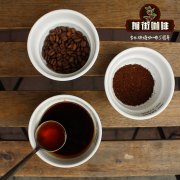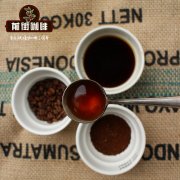Is coffee hard for the senses? Four stages of coffee sensory evaluation How to taste single coffee

Professional coffee knowledge exchange more coffee bean information please follow the coffee workshop (Wechat official account cafe_style)
Sensory experts have done experiments that when you smell food or drink, you can be 80% sure what it is. To the coffee senses, the "sense of smell" is like a key, which can help us better perceive and experience the beauty of coffee.
The memory of smell and taste is very short, and each of us will empathize with it. There is data showing that even for things we are familiar with, the accuracy of smell will drop to 65% or even lower after a year.
Short memories and abstract expressions make us have more difficulties in communicating coffee, just like when we talk about the taste of "lemon", another person will feel the same way, but when we talk about "passionflower", people who haven't eaten it for a long time will feel very vague. If taste is a language, then universal standards become crucial.
When drinking coffee, we mainly focus on the sensory experience of taste, smell and touch. What is taste?. Everyone should be familiar with it, that is, sour, sweet, bitter, fresh and salty, and coffee has four flavors at the same time (except the fresh taste), but the salty taste is not necessarily there. Many factors, such as the roasting degree of coffee beans and the way they are brewed, will affect the taste of the coffee. For example, the more shallow the coffee is, the more sour it is.
It is easier to recognize the difference between coffee by smell than by taste. Many people think that smell refers to the smell of the nose before eating, but in fact, the sense of smell works all the time when the food is chewed in the mouth or even after it is swallowed. The sense of smell behind the nose can help you identify most flavors, but many people often confuse various sensory experiences when describing flavor. Produce some vague words, such as astringency, restlessness, and so on, which should actually be called astringency and restlessness (touch). If you separate the various senses clearly when eating, you can improve your sensory ability.
For example, the taste part is sour, sweet, bitter and salty, so when you hear someone describe Yega Xuefei's coffee as having a "citrus flavor", you should know that he means "aroma", that is, from the "sense of smell". Taste and smell should be separated clearly. Citrus-flavored coffee does not mean that the acidity is as sour as citrus. Therefore, sometimes I wonder why others can drink a lot of coffee flavor, but there is nothing I can do about it. In fact, it is not necessarily because my senses are poor, but I confuse all kinds of senses, and it is very important to train my sense of smell and taste. But if you want to experience the beauty of fine coffee, I think you will gain more benefits by training your sense of smell than by training your sense of taste.
The cultivation of coffee taster will vary according to each person's different life experience. You should increase your senses and remember the taste of what you have eaten and drank. And remember consciously: "for example, when you smell a cup of Panamanian-geisha coffee, the person next to you immediately says it smells like jasmine, but at the moment you think it's the smell from the yard next door, so you can go to the next yard to have a look." Smell the smell, and then find the real jasmine to smell, although the next door is egg flower, but the taste is also very similar to jasmine, which increases your database of taste, but also a conscious memory. "
To taste fruits, spices, essential oils... These things with rich flavors are a way to train your sense of taste. And the most important thing is to hold a curious heart to taste in order to feel and remember. Next, to learn to describe the taste, through the blind test in the cup test, let us discuss the taste of each other.
Important Notice :
前街咖啡 FrontStreet Coffee has moved to new addredd:
FrontStreet Coffee Address: 315,Donghua East Road,GuangZhou
Tel:020 38364473
- Prev

What is blended coffee? how do you mix coffee beans? what is blended coffee beans?
Professional coffee knowledge exchange more coffee bean information please follow the coffee workshop (Wechat official account cafe_style) in this era, people have an extraordinary pursuit of nature and purity. When the all-natural, 100% unadded words become the standard of the times, pure single coffee has become the magic weapon of cafes that sell boutique coffee. These are marked with single production.
- Next

The fourth wave of coffee has arrived. Coffee has four trends. Future development trend of coffee.
Professional coffee knowledge exchange more coffee bean information please follow the coffee workshop (Wechat official account cafe_style) what is the coffee trend (revolution)? There are a total of three waves: the first wave (1940-1960): the "first wave" of instant coffee before and after World War II, instant coffee (and Robasta beans) prevailed, the poor quality led to the consumption of coffee, and in order to keep down the cost.
Related
- Beginners will see the "Coffee pull flower" guide!
- What is the difference between ice blog purified milk and ordinary milk coffee?
- Why is the Philippines the largest producer of crops in Liberia?
- For coffee extraction, should the fine powder be retained?
- How does extracted espresso fill pressed powder? How much strength does it take to press the powder?
- How to make jasmine cold extract coffee? Is the jasmine + latte good?
- Will this little toy really make the coffee taste better? How does Lily Drip affect coffee extraction?
- Will the action of slapping the filter cup also affect coffee extraction?
- What's the difference between powder-to-water ratio and powder-to-liquid ratio?
- What is the Ethiopian local species? What does it have to do with Heirloom native species?

